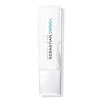What's inside
What's inside
 Key Ingredients
Key Ingredients

No key ingredients
 Benefits
Benefits

 Concerns
Concerns

 Ingredients Side-by-side
Ingredients Side-by-side

Water
Skin ConditioningStearyl Alcohol
EmollientCetyl Alcohol
EmollientBehenamidopropyl Dimethylamine
EmulsifyingGlutamic Acid
HumectantBenzyl Alcohol
PerfumingPhenoxyethanol
PreservativeBis-Aminopropyl Dimethicone
Parfum
MaskingMethylparaben
PreservativePropylparaben
PreservativeEDTA
Linalool
PerfumingSodium Chloride
MaskingCitric Acid
BufferingButylphenyl Methylpropional
PerfumingCyclomethicone
EmollientHydroxyisohexyl 3-Cyclohexene Carboxaldehyde
MaskingHydrolyzed Silk
HumectantOryza Sativa Bran Oil
EmollientSimmondsia Chinensis Seed Oil
EmollientCyclotetrasiloxane
EmollientPropylene Glycol
HumectantAstragalus Gummifer Gum
Emulsion StabilisingWater, Stearyl Alcohol, Cetyl Alcohol, Behenamidopropyl Dimethylamine, Glutamic Acid, Benzyl Alcohol, Phenoxyethanol, Bis-Aminopropyl Dimethicone, Parfum, Methylparaben, Propylparaben, EDTA, Linalool, Sodium Chloride, Citric Acid, Butylphenyl Methylpropional, Cyclomethicone, Hydroxyisohexyl 3-Cyclohexene Carboxaldehyde, Hydrolyzed Silk, Oryza Sativa Bran Oil, Simmondsia Chinensis Seed Oil, Cyclotetrasiloxane, Propylene Glycol, Astragalus Gummifer Gum
Water
Skin ConditioningCetearyl Alcohol
EmollientStearyl Alcohol
EmollientStearalkonium Chloride
PreservativeBehentrimonium Chloride
PreservativeBiotin
AntiseborrhoeicPanthenol
Skin ConditioningTocopherol
AntioxidantAscorbyl Palmitate
AntioxidantTocopheryl Acetate
AntioxidantAscorbic Acid
AntioxidantPyridoxine Hcl
Skin ConditioningTerminalia Ferdinandiana Fruit Extract
AntioxidantUndaria Pinnatifida Extract
Skin ConditioningButyrospermum Parkii Butter
Skin ConditioningOenothera Biennis Oil
EmollientJojoba Esters
EmollientCitrus Aurantium Bergamia Fruit Extract
Skin ConditioningArctium Lappa Root Extract
Skin ConditioningCentella Asiatica Extract
CleansingRosa Canina Fruit Oil
EmollientGlycerin
HumectantIsopropyl Alcohol
SolventCetrimonium Chloride
AntimicrobialAmodimethicone
Guar Hydroxypropyltrimonium Chloride
Skin ConditioningSilicone Quaternium-18
EmollientTrideceth-6
EmulsifyingTrideceth-12
EmulsifyingPolyquaternium-7
BHT
AntioxidantPhenoxyethanol
PreservativeEthylhexylglycerin
Skin ConditioningChlorphenesin
AntimicrobialPotassium Sorbate
PreservativeSodium Benzoate
MaskingCitric Acid
BufferingParfum
MaskingBenzyl Benzoate
AntimicrobialLimonene
PerfumingWater, Cetearyl Alcohol, Stearyl Alcohol, Stearalkonium Chloride, Behentrimonium Chloride, Biotin, Panthenol, Tocopherol, Ascorbyl Palmitate, Tocopheryl Acetate, Ascorbic Acid, Pyridoxine Hcl, Terminalia Ferdinandiana Fruit Extract, Undaria Pinnatifida Extract, Butyrospermum Parkii Butter, Oenothera Biennis Oil, Jojoba Esters, Citrus Aurantium Bergamia Fruit Extract, Arctium Lappa Root Extract, Centella Asiatica Extract, Rosa Canina Fruit Oil, Glycerin, Isopropyl Alcohol, Cetrimonium Chloride, Amodimethicone, Guar Hydroxypropyltrimonium Chloride, Silicone Quaternium-18, Trideceth-6, Trideceth-12, Polyquaternium-7, BHT, Phenoxyethanol, Ethylhexylglycerin, Chlorphenesin, Potassium Sorbate, Sodium Benzoate, Citric Acid, Parfum, Benzyl Benzoate, Limonene
 Reviews
Reviews

Ingredients Explained
These ingredients are found in both products.
Ingredients higher up in an ingredient list are typically present in a larger amount.
Citric Acid is an alpha hydroxy acid (AHA) naturally found in citrus fruits like oranges, lemons, and limes.
Like other AHAs, citric acid can exfoliate skin by breaking down the bonds that hold dead skin cells together. This helps reveal smoother and brighter skin underneath.
However, this exfoliating effect only happens at high concentrations (20%) which can be hard to find in cosmetic products.
Due to this, citric acid is usually included in small amounts as a pH adjuster. This helps keep products slightly more acidic and compatible with skin's natural pH.
In skincare formulas, citric acid can:
While it can provide some skin benefits, research shows lactic acid and glycolic acid are generally more effective and less irritating exfoliants.
Most citric acid used in skincare today is made by fermenting sugars (usually from molasses). This synthetic version is identical to the natural citrus form but easier to stabilize and use in formulations.
Read more about some other popular AHA's here:
Learn more about Citric AcidParfum is a catch-all term for an ingredient or more that is used to give a scent to products.
Also called "fragrance", this ingredient can be a blend of hundreds of chemicals or plant oils. This means every product with "fragrance" or "parfum" in the ingredients list is a different mixture.
For instance, Habanolide is a proprietary trade name for a specific aroma chemical. When used as a fragrance ingredient in cosmetics, most aroma chemicals fall under the broad labeling category of “FRAGRANCE” or “PARFUM” according to EU and US regulations.
The term 'parfum' or 'fragrance' is not regulated in many countries. In many cases, it is up to the brand to define this term.
For instance, many brands choose to label themselves as "fragrance-free" because they are not using synthetic fragrances. However, their products may still contain ingredients such as essential oils that are considered a fragrance by INCI standards.
One example is Calendula flower extract. Calendula is an essential oil that still imparts a scent or 'fragrance'.
Depending on the blend, the ingredients in the mixture can cause allergies and sensitivities on the skin. Some ingredients that are known EU allergens include linalool and citronellol.
Parfum can also be used to mask or cover an unpleasant scent.
The bottom line is: not all fragrances/parfum/ingredients are created equally. If you are worried about fragrances, we recommend taking a closer look at an ingredient. And of course, we always recommend speaking with a professional.
Learn more about ParfumPhenoxyethanol is a preservative that has germicide, antimicrobial, and aromatic properties. Studies show that phenoxyethanol can prevent microbial growth. By itself, it has a scent that is similar to that of a rose.
It's often used in formulations along with Caprylyl Glycol to preserve the shelf life of products.
Stearyl Alcohol is a type of fatty alcohol from stearic acid. It is a white, waxy compound used to emulsify ingredients.
Fatty Alcohols are most often used as an emollient or to thicken a product. Emollients help soothe and hydrate the skin by trapping moisture.
They are usually derived from natural fats and oils and therefore do not have the same drying or irritating effect as solvent alcohols. FDA allows products labeled "alcohol-free" to have fatty alcohols.
Learn more about Stearyl AlcoholWater. It's the most common cosmetic ingredient of all. You'll usually see it at the top of ingredient lists, meaning that it makes up the largest part of the product.
So why is it so popular? Water most often acts as a solvent - this means that it helps dissolve other ingredients into the formulation.
You'll also recognize water as that liquid we all need to stay alive. If you see this, drink a glass of water. Stay hydrated!
Learn more about Water